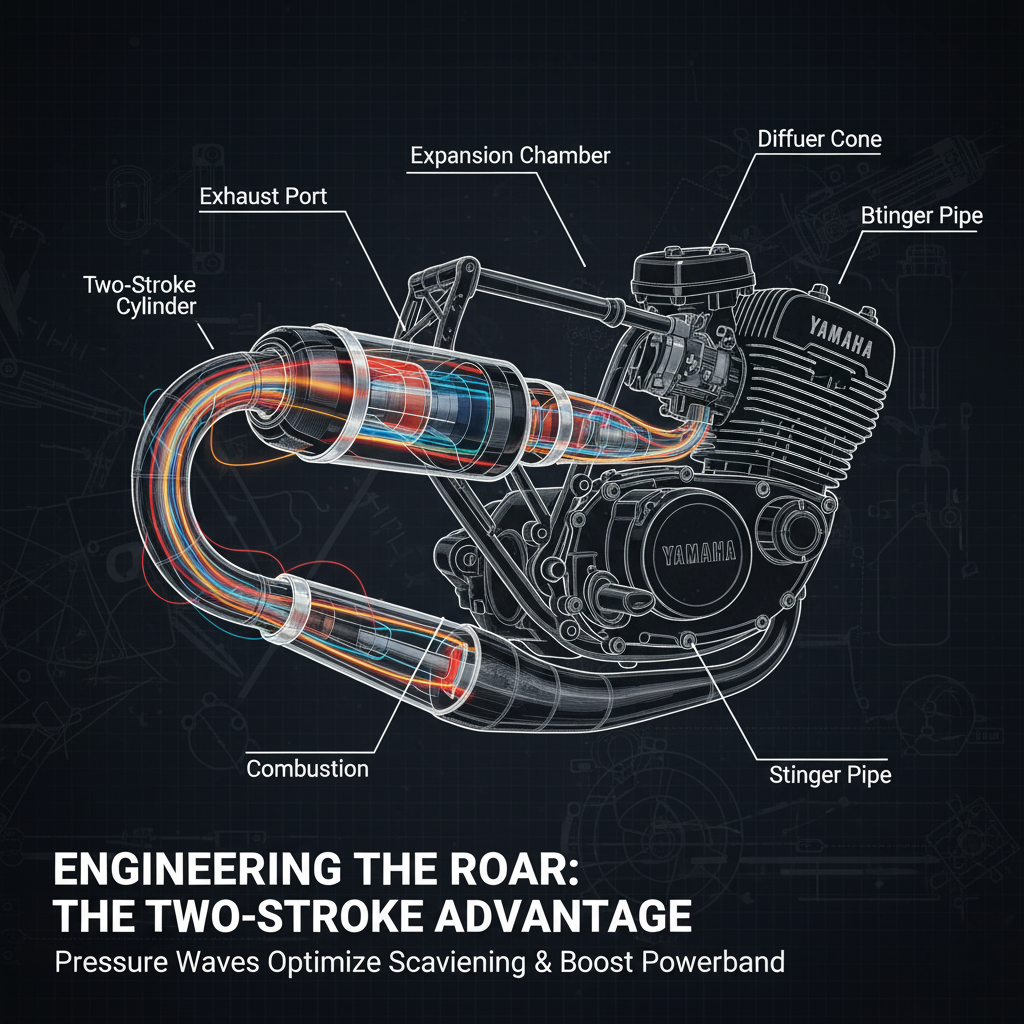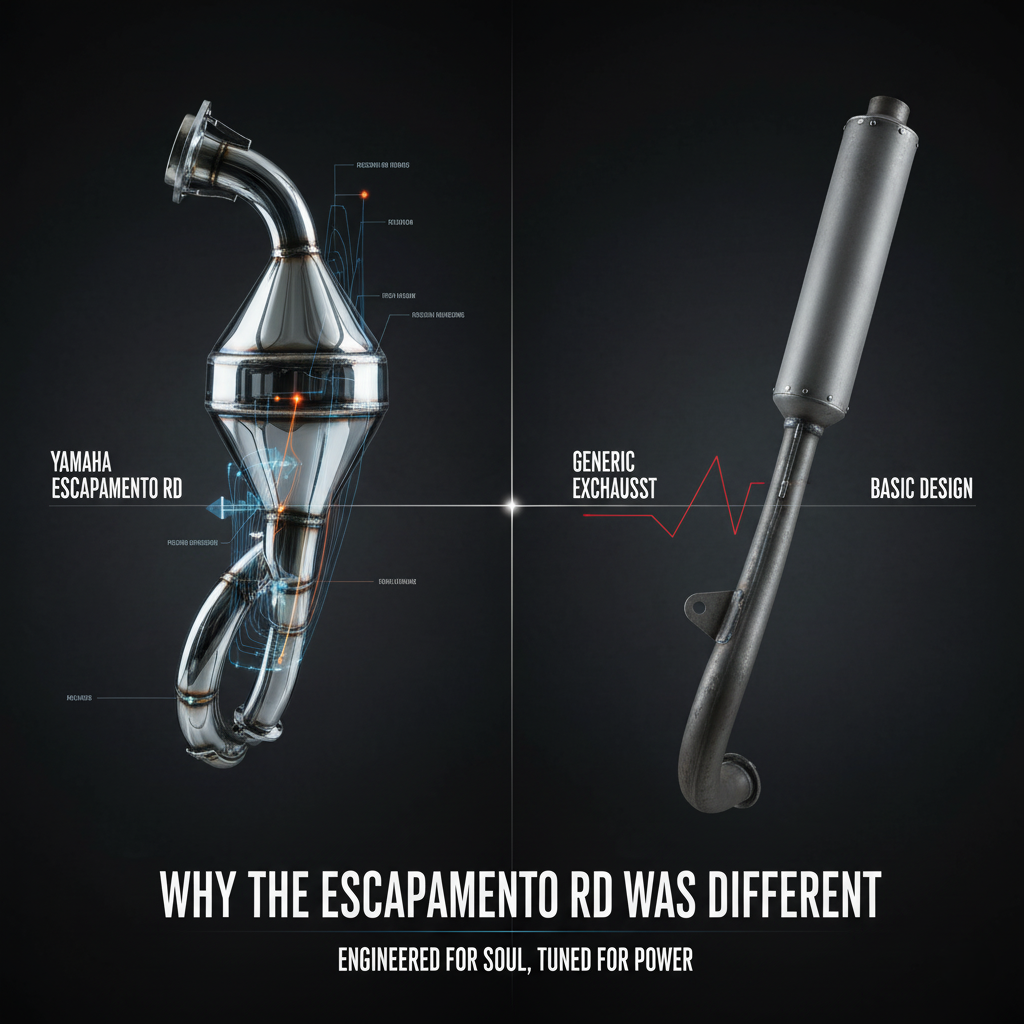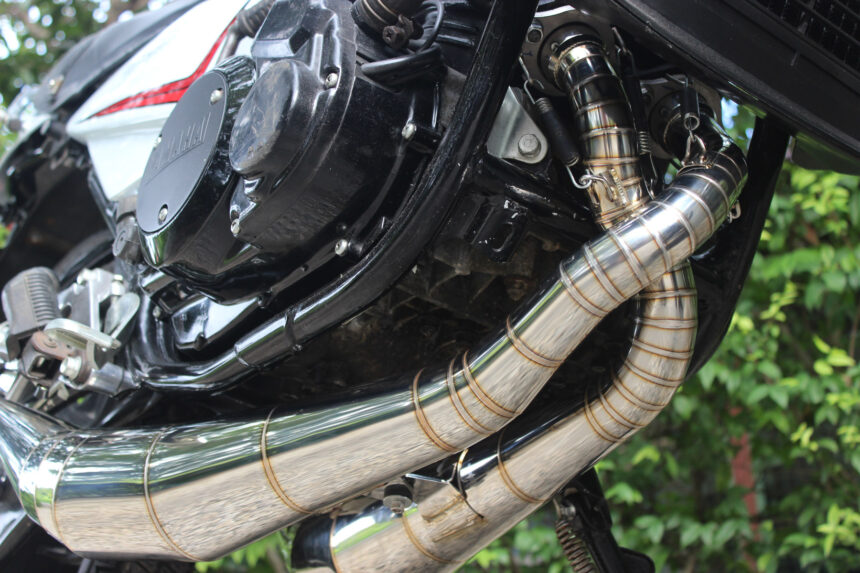Introduction – What Is Escapamento RD?
If you’ve ever heard the unmistakable crackle and roar of a classic Yamaha RD motorcycle speeding past, chances are the sound came from its most iconic feature: the escapamento RD. The term “escapamento” simply means exhaust system in Portuguese, but among motorcycle enthusiasts — especially in Brazil and around the world — it refers to far more than a mechanical part. The Escapamento RD is a piece of history, engineering, and culture all rolled into one.
At its core, the RD exhaust system was designed for Yamaha’s legendary RD series of two-stroke motorcycles. These bikes — known for their lightweight construction, aggressive acceleration, and unforgettable sound — became some of the most beloved machines of the 1970s, 80s, and early 90s. But the exhaust wasn’t just a functional necessity; it was a defining element of the RD identity.
Whether you’re a seasoned rider who grew up with an RD 350 screaming through city streets or a younger enthusiast exploring vintage two-strokes, understanding the escapamento RD is key to appreciating why these bikes remain so influential. This exhaust isn’t just about pipes and metal — it’s about performance, sound, heritage, and the emotional connection between rider and machine.
Origins of the Yamaha RD Series – Where It All Began
The story of the Escapamento RD begins with the birth of the Yamaha RD series itself. “RD” stands for Race Developed, and that name was no marketing gimmick — these bikes were bred for performance from the start. Yamaha introduced the RD line in the early 1970s as successors to its earlier two-stroke street machines. They quickly earned a reputation for delivering racing-level excitement in a street-legal package.
The RD series ranged from smaller displacement models like the RD 125 and RD 135 — perfect for city riding and beginners — to the legendary RD 250 and RD 350, which became symbols of speed and rebellion. Lightweight, nimble, and unbelievably fast for their size, RD motorcycles dominated the streets and even made waves on the racetrack.
But what truly set these bikes apart was how they delivered their power. Two-stroke engines, by nature, rely heavily on precise exhaust design to manage pressure waves and optimize performance. Yamaha engineers knew this, and they poured considerable effort into developing an exhaust system — the escapamento RD — that could unleash the full potential of these engines. It wasn’t just an accessory; it was an essential piece of the RD’s DNA.
The Function of Escapamento RD in Two-Stroke Engines

To appreciate why the Escapamento RD is so iconic, it’s important to understand what it actually does. In a two-stroke engine, the exhaust system isn’t just a way to expel burnt gases — it’s a critical component of the power delivery system itself. Unlike four-stroke engines, two-strokes rely on the exhaust’s design to help with scavenging (clearing out exhaust gases) and even drawing in the next fuel-air charge.
The Escapamento RD was meticulously designed to create a pressure wave effect. As the exhaust gases exit the combustion chamber, they form pulses that travel through the exhaust pipe. The pipe’s shape — especially the expansion chamber — reflects these pulses back into the cylinder at precisely the right moment. This helps push unburned fuel-air mixture back into the combustion chamber, boosting power and efficiency.
Some of the core functions of the RD exhaust include:
-
Powerband Optimization: By tuning the length and shape of the exhaust, Yamaha engineers created a sharp, explosive powerband — one of the hallmarks of RD motorcycles.
-
Improved Scavenging: The exhaust’s design ensures that exhaust gases are expelled efficiently, preventing power loss.
-
Signature Sound: The expansion chamber doesn’t just improve performance — it gives the RD its unforgettable “ring-ding” exhaust note.
This combination of science and art is why enthusiasts often refer to the escapamento RD as the heart of the bike. It’s not just a component; it’s what makes an RD feel like an RD.
| Function | Role in the Engine | Performance Impact |
|---|---|---|
| Gas Expulsion | Efficiently removes burnt exhaust gases from the combustion chamber. | Prevents engine choking and ensures smooth power delivery. |
| Airflow Optimization | Balances intake and exhaust flow for better combustion. | Achieves cleaner combustion and sharper throttle response. |
| Acoustic Identity | Creates the unmistakable two-stroke sound signature. | Defines the RD’s personality and builds emotional connection. |
| Heat Management | Regulates heat during the fast two-stroke cycle. | Improves engine durability and maintains performance consistency. |
Why the Escapamento RD Was Different

While many motorcycles from the same era had basic exhaust designs, Yamaha’s approach to the RD exhaust was anything but ordinary. The company invested significant time and research into creating a system that balanced performance, reliability, and character — and the result was an exhaust unlike anything riders had experienced before.
One of the main differences was the precision of the expansion chamber design. Where other manufacturers might have used simpler, straight pipes, Yamaha’s RD exhausts featured carefully calculated shapes that maximized resonance and improved mid- to high-range power delivery. This is why even smaller RDs, like the 125 and 135, felt far more powerful than their displacement suggested.
Additionally, the RD exhaust was designed to complement the bike’s riding dynamics. Because these bikes were lightweight and agile, Yamaha focused on creating an exhaust that enhanced throttle response and acceleration. Riders didn’t just feel the power — they heard and lived it every time they twisted the throttle.
Perhaps most importantly, the escapamento RD had a character all its own. From its signature sound to its role in defining the RD’s explosive personality, this exhaust wasn’t just different — it was iconic. Riders quickly learned to identify an RD by sound alone, long before the bike even came into view.
The Sound That Defined a Generation
For many enthusiasts, the most unforgettable aspect of the escapamento RD isn’t its engineering — it’s the sound. That high-pitched, crackling, and almost musical note is unlike anything produced by modern four-stroke motorcycles. It’s a sound that can transport riders back to their youth, remind them of late-night rides, or bring a smile to their face even decades later.
The RD’s exhaust note wasn’t an accident. It was the direct result of the expansion chamber’s design, the two-stroke firing pattern, and the rapid combustion cycles that defined these engines. Together, they created a sound that was as much a part of the RD experience as the speed or handling.
Motorcycle enthusiasts often describe the RD’s exhaust note in emotional terms:
-
Distinctive: Instantly recognizable, even from a distance.
-
Addictive: Encouraging riders to push the throttle just to hear it sing.
-
Nostalgic: A living link to the golden era of two-stroke motorcycles.
This sound became more than noise — it became an identity. In the streets of São Paulo, the alleys of Tokyo, or the backroads of Europe, the unmistakable ring-ding of an RD exhaust meant freedom, rebellion, and pure joy.
RD 125 and RD 135: Lightweight Fun
While the larger RD 250 and 350 often steal the spotlight, the RD 125 and RD 135 deserve special recognition for introducing a generation of riders to the escapamento RD experience. These smaller-displacement bikes were light, affordable, and surprisingly quick — perfect for beginners and city riders who still wanted a taste of Yamaha’s two-stroke magic.
The exhaust systems on these models were tuned to deliver responsive power and a lively riding feel. Even though they lacked the raw horsepower of their bigger siblings, the smaller RDs still packed plenty of character. Riders loved the way the exhaust note climbed eagerly through the rev range, and how the lightweight chassis made them nimble in traffic or on twisty roads.
Moreover, the 125 and 135 models were often the first motorcycles young riders owned. That meant the escapamento RD was more than just a performance feature — it was part of their coming-of-age story. For many, the memory of that signature sound and feel is something they’ll never forget.
RD 250 and RD 350: The True Icons
While the smaller RDs offered accessibility and fun, the RD 250 and RD 350 were the bikes that truly cemented Yamaha’s place in motorcycle history. These were machines that pushed the limits of what two-stroke street bikes could do — and the escapamento RD played a massive role in their success.
The RD 250, with its well-balanced performance, was often considered the perfect blend of everyday usability and weekend thrill. But it was the RD 350 that became the stuff of legends. Light, agile, and packing an explosive powerband, it could embarrass much larger four-stroke machines on the street and the track. Much of that performance was thanks to the carefully tuned exhaust system, which helped extract every ounce of power from its two-stroke heart.
Beyond raw performance, the RD 250 and 350 became cultural icons. They were the bikes that defined a generation of riders — rebellious, adventurous, and hungry for speed. The sound of their escapamento wasn’t just a technical achievement; it was a rallying cry for an entire motorcycle movement.
Escapamento RD and the Tuning Culture

One of the most fascinating aspects of the RD legacy is how deeply it influenced motorcycle tuning culture. Riders quickly discovered that by modifying the escapamento, they could significantly change the bike’s character. Whether they were seeking more top-end power, a broader torque curve, or a more aggressive sound, tuning the exhaust became a rite of passage for RD owners.
Tuning often involved experimenting with different expansion chamber designs, lengths, and diameters. Aftermarket manufacturers began offering a range of performance exhausts, each with its own characteristics. Some focused on maximizing peak horsepower for racing, while others aimed to improve mid-range punch for street riding.
Key areas tuners typically focused on included:
-
Expansion Chamber Shape: Altering the chamber profile could change how the powerband behaved.
-
Header Length and Diameter: Adjusting these affected exhaust pulse timing and scavenging efficiency.
-
Material Choices: Lightweight materials like stainless steel or aluminum could improve response and reduce weight.
For many, the process of fine-tuning the escapamento wasn’t just about performance — it was a form of personal expression. Each RD exhaust was a statement about how the rider wanted their machine to behave and sound.
The Role of Escapamento RD in Racing
It’s impossible to discuss the legacy of the RD without acknowledging its influence on racing. From club-level competitions to international events, RD motorcycles dominated tracks throughout the 1970s and 1980s. And once again, the escapamento RD was a crucial factor in their success.
Racing teams and privateers quickly learned that optimizing the exhaust could yield massive performance gains. A well-tuned exhaust system allowed RD engines to rev higher, produce more horsepower, and deliver power more smoothly — all essential qualities for competitive racing. Yamaha’s racing heritage also directly influenced the design of its street bikes, with many of the exhaust technologies used in race machines eventually making their way into production RDs.
The success of these bikes in competition helped cement the RD’s reputation as more than just a street bike. They were genuine race-bred machines — fast, agile, and responsive — and the escapamento was at the center of that identity. Even today, vintage racing events around the world still feature RDs with custom exhaust systems, a testament to their enduring appeal.
Escapamento RD in Brazilian and Global Motorcycle Culture
While the RD series found fans all over the world, few countries embraced it as passionately as Brazil. In the 1980s and 1990s, the RD 135 and 350 were not just motorcycles — they were cultural icons. The sound of an RD exhaust echoing through city streets became a familiar soundtrack to urban life, symbolizing youth, freedom, and individuality.
In Brazil, the escapamento RD was often modified to make the bikes louder and more aggressive — a reflection of the local motorcycle culture’s emphasis on personality and expression. Enthusiast groups, riding clubs, and even street racing scenes grew around these machines, further cementing their cultural status.
Globally, the RD’s exhaust note became a universal language among motorcycle lovers. From Europe to Asia, riders recognized that distinct two-stroke song. It represented a shared passion for performance, a connection across borders, and a reminder of an era when motorcycles were raw, mechanical, and deeply engaging.
| Cultural Element | Symbolism | Impact |
|---|---|---|
| Sound as Freedom | The ring-ding exhaust note symbolizes adrenaline, independence, and unity. | Builds a strong sense of community and group belonging. |
| Custom Design as Self-Expression | Personalized exhaust modifications reflect rider identity. | Connects riders with local motorcycle culture and trends. |
| Nostalgia and Memory | Brings back memories of teenage rides and classic two-stroke eras. | Fuels the global vintage restoration movement. |
| Racing Heritage | Represents raw speed and competition history. | Keeps the RD’s race-bred spirit alive in modern motorcycle culture. |
Modern-Day Escapamento RD – Restoration, Innovation & Simulation
Even though Yamaha ceased production of the RD series decades ago, the escapamento RD continues to thrive in the modern era — albeit in new and interesting ways. Vintage motorcycle enthusiasts now treat RD bikes as prized collectibles, and restoring their exhaust systems to original condition is often a central part of the process.
Many restoration projects involve painstakingly sourcing original exhausts or reproducing them with modern materials and techniques. Others choose to blend old and new, fitting period-correct bikes with modern performance exhausts that maintain the classic character while offering improved reliability and tuning options.
There’s also a growing interest in digital sound simulation. Some electric motorcycle projects and retro-styled customs now incorporate systems that mimic the RD’s exhaust note — proof of just how iconic that sound remains. It’s a testament to the fact that the escapamento RD is more than just a piece of metal; it’s an experience that riders still crave, even in a changing motorcycle landscape.
Why Escapamento RD Still Matters in 2025
In an era of high-tech electronics, emission regulations, and electric motorcycles, you might think the escapamento RD would fade into obscurity. Yet, its legacy is stronger than ever. The RD exhaust represents a time when motorcycles were pure, mechanical, and full of soul — when performance was about feel as much as numbers.
Collectors, restorers, and enthusiasts continue to celebrate the escapamento RD because it embodies something that modern machines often lack: character. Its sound, its performance, and its cultural impact remind us why we fell in love with motorcycles in the first place. And as long as there are riders who value those qualities, the escapamento RD will always have a place on the road and in our hearts.
Why Escapamento RD Still Matters Today
Even in 2025, the escapamento RD’s influence remains strong. Its importance goes beyond nostalgia — it’s a living legacy that continues to shape motorcycle culture and engineering:
-
🔧 Preserves Performance Heritage: It keeps the two-stroke spirit alive, maintaining the mechanical DNA that defined decades of performance bikes.
-
🔊 Delivers Iconic Sound: No modern machine can replicate the acoustic identity of an RD exhaust — a sound that defined generations of riders.
-
🧠 Inspires Engineering Innovation: Its precision design continues to influence how exhaust systems are tuned for performance and character.
-
🕰️ Connects Generations: It bridges the gap between 1970s racers and modern restoration experts, creating a shared passion across time.
-
🏍️ Fuels a Global Community: Thousands of enthusiasts worldwide still build, restore, and share RD content, united by a love for that unmistakable exhaust note.
Challenges, Regulations & Criticism
Of course, the escapamento RD hasn’t been without its challenges. Two-stroke engines are notorious for their emissions, and many countries have introduced strict noise and pollution regulations that make owning or modifying RD exhausts more difficult. In some regions, heavily modified systems are no longer street-legal.
There’s also the issue of maintenance. Older exhaust systems require regular care to prevent carbon buildup and corrosion, and sourcing parts can be difficult as original components become rarer. Despite these obstacles, the RD community remains strong — often finding creative ways to keep these machines running while staying compliant with modern laws.
Ultimately, these challenges are part of the RD story. They underscore just how beloved these bikes and their exhausts are, and how dedicated enthusiasts are to preserving their legacy.
Future of Escapamento RD – Where Do We Go From Here?
The future of the escapamento RD lies at the intersection of tradition and innovation. While environmental concerns and new technologies will continue to shape the motorcycle industry, there will always be a place for classic two-strokes — whether as restored originals, track-day toys, or museum pieces.
Manufacturers and custom builders are also exploring ways to modernize two-stroke technology, incorporating cleaner combustion techniques and synthetic fuels. These advances could one day allow a new generation of RD-inspired machines — complete with their signature exhaust note — to hit the roads again.
In the meantime, the escapamento RD remains a symbol of what motorcycles once were — raw, visceral, and deeply emotional. Its story is far from over.
FAQs About Escapamento RD
1. What is Escapamento RD?
It’s the exhaust system used on Yamaha’s legendary RD series of two-stroke motorcycles. Beyond its basic function, it’s known for dramatically affecting performance and producing the RD’s signature sound.
2. Why is the RD exhaust so special?
Its unique design uses pressure waves to improve engine efficiency and power, while its distinct sound has become one of the most recognizable in motorcycle history.
3. Can I still find original RD exhausts today?
Yes, though they’re increasingly rare. Many restorers use reproduction systems or custom-made replicas to achieve similar performance and sound.
4. Is it legal to modify an RD exhaust?
It depends on local laws. Some regions have strict noise or emissions regulations, so it’s important to check before installing aftermarket systems.
5. Are RD exhausts still relevant in 2025?
Absolutely. Their legacy continues to influence modern motorcycle design, and enthusiasts around the world still celebrate their sound, performance, and heritage.
Final Thoughts
The escapamento RD is far more than a collection of metal tubes welded together — it’s a piece of living motorcycle history. It shaped the performance, identity, and legacy of one of Yamaha’s most beloved series. Its distinctive sound defined an era, its performance pushed boundaries, and its cultural impact transcended borders.
In a world where motorcycles are becoming increasingly silent and computerized, the escapamento RD stands as a reminder of why we ride in the first place: for the connection between man and machine, the thrill of acceleration, and the pure joy of a perfectly tuned two-stroke exhaust singing at full throttle. Its legacy will continue to inspire riders for generations to come.
For more quality, informative content, visit writewhiz






